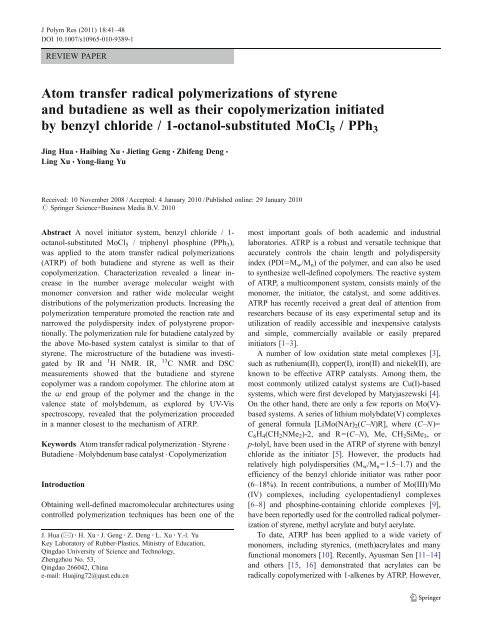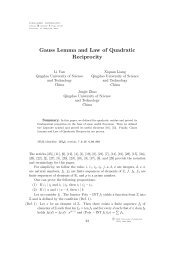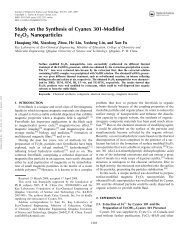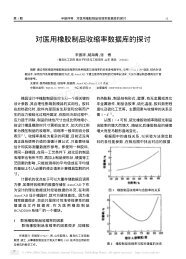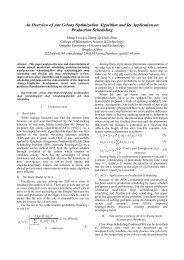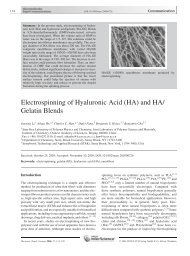Atom transfer radical polymerizations of styrene and butadiene as ...
Atom transfer radical polymerizations of styrene and butadiene as ...
Atom transfer radical polymerizations of styrene and butadiene as ...
Create successful ePaper yourself
Turn your PDF publications into a flip-book with our unique Google optimized e-Paper software.
J Polym Res (2011) 18:41–48<br />
DOI 10.1007/s10965-010-9389-1<br />
REVIEW PAPER<br />
<strong>Atom</strong> <strong>transfer</strong> <strong>radical</strong> <strong>polymerizations</strong> <strong>of</strong> <strong>styrene</strong><br />
<strong>and</strong> <strong>butadiene</strong> <strong>as</strong> well <strong>as</strong> their copolymerization initiated<br />
by benzyl chloride / 1-octanol-substituted MoCl 5 / PPh 3<br />
Jing Hua & Haibing Xu & Jieting Geng & Zhifeng Deng &<br />
Ling Xu & Yong-liang Yu<br />
Received: 10 November 2008 /Accepted: 4 January 2010 /Published online: 29 January 2010<br />
# Springer Science+Business Media B.V. 2010<br />
Abstract A novel initiator system, benzyl chloride / 1-<br />
octanol-substituted MoCl 5 / triphenyl phosphine (PPh 3 ),<br />
w<strong>as</strong> applied to the atom <strong>transfer</strong> <strong>radical</strong> <strong>polymerizations</strong><br />
(ATRP) <strong>of</strong> both <strong>butadiene</strong> <strong>and</strong> <strong>styrene</strong> <strong>as</strong> well <strong>as</strong> their<br />
copolymerization. Characterization revealed a linear incre<strong>as</strong>e<br />
in the number average molecular weight with<br />
monomer conversion <strong>and</strong> rather wide molecular weight<br />
distributions <strong>of</strong> the polymerization products. Incre<strong>as</strong>ing the<br />
polymerization temperature promoted the reaction rate <strong>and</strong><br />
narrowed the polydispersity index <strong>of</strong> poly<strong>styrene</strong> proportionally.<br />
The polymerization rule for <strong>butadiene</strong> catalyzed by<br />
the above Mo-b<strong>as</strong>ed system catalyst is similar to that <strong>of</strong><br />
<strong>styrene</strong>. The microstructure <strong>of</strong> the <strong>butadiene</strong> w<strong>as</strong> investigated<br />
by IR <strong>and</strong> 1 H NMR. IR,<br />
13 C NMR <strong>and</strong> DSC<br />
me<strong>as</strong>urements showed that the <strong>butadiene</strong> <strong>and</strong> <strong>styrene</strong><br />
copolymer w<strong>as</strong> a r<strong>and</strong>om copolymer. The chlorine atom at<br />
the ω end group <strong>of</strong> the polymer <strong>and</strong> the change in the<br />
valence state <strong>of</strong> molybdenum, <strong>as</strong> explored by UV-Vis<br />
spectroscopy, revealed that the polymerization proceeded<br />
in a manner closest to the mechanism <strong>of</strong> ATRP.<br />
Keywords <strong>Atom</strong> <strong>transfer</strong> <strong>radical</strong> polymerization . Styrene .<br />
Butadiene . Molybdenum b<strong>as</strong>e catalyst . Copolymerization<br />
Introduction<br />
Obtaining well-defined macromolecular architectures using<br />
controlled polymerization techniques h<strong>as</strong> been one <strong>of</strong> the<br />
J. Hua (*) : H. Xu : J. Geng : Z. Deng : L. Xu : Y.-l. Yu<br />
Key Laboratory <strong>of</strong> Rubber-Pl<strong>as</strong>tics, Ministry <strong>of</strong> Education,<br />
Qingdao University <strong>of</strong> Science <strong>and</strong> Technology,<br />
Zhengzhou No. 53,<br />
Qingdao 266042, China<br />
e-mail: Huajing72@qust.edu.cn<br />
most important goals <strong>of</strong> both academic <strong>and</strong> industrial<br />
laboratories. ATRP is a robust <strong>and</strong> versatile technique that<br />
accurately controls the chain length <strong>and</strong> polydispersity<br />
index (PDI=M w /M n ) <strong>of</strong> the polymer, <strong>and</strong> can also be used<br />
to synthesize well-defined copolymers. The reactive system<br />
<strong>of</strong> ATRP, a multicomponent system, consists mainly <strong>of</strong> the<br />
monomer, the initiator, the catalyst, <strong>and</strong> some additives.<br />
ATRP h<strong>as</strong> recently received a great deal <strong>of</strong> attention from<br />
researchers because <strong>of</strong> its e<strong>as</strong>y experimental setup <strong>and</strong> its<br />
utilization <strong>of</strong> readily accessible <strong>and</strong> inexpensive catalysts<br />
<strong>and</strong> simple, commercially available or e<strong>as</strong>ily prepared<br />
initiators [1–3].<br />
A number <strong>of</strong> low oxidation state metal complexes [3],<br />
such <strong>as</strong> ruthenium(II), copper(I), iron(II) <strong>and</strong> nickel(II), are<br />
known to be effective ATRP catalysts. Among them, the<br />
most commonly utilized catalyst systems are Cu(I)-b<strong>as</strong>ed<br />
systems, which were first developed by Matyj<strong>as</strong>zewski [4].<br />
On the other h<strong>and</strong>, there are only a few reports on Mo(V)-<br />
b<strong>as</strong>ed systems. A series <strong>of</strong> lithium molybdate(V) complexes<br />
<strong>of</strong> general formula [LiMo(NAr) 2 (C–N)R], where (C–N)=<br />
C 6 H 4 (CH 2 NMe 2 )-2, <strong>and</strong> R=(C–N), Me, CH 2 SiMe 3 , or<br />
p-tolyl, have been used in the ATRP <strong>of</strong> <strong>styrene</strong> with benzyl<br />
chloride <strong>as</strong> the initiator [5]. However, the products had<br />
relatively high polydispersities (M w /M n =1.5–1.7) <strong>and</strong> the<br />
efficiency <strong>of</strong> the benzyl chloride initiator w<strong>as</strong> rather poor<br />
(6–18%). In recent contributions, a number <strong>of</strong> Mo(III)/Mo<br />
(IV) complexes, including cyclopentadienyl complexes<br />
[6–8] <strong>and</strong> phosphine-containing chloride complexes [9],<br />
have been reportedly used for the controlled <strong>radical</strong> polymerization<br />
<strong>of</strong> <strong>styrene</strong>, methyl acrylate <strong>and</strong> butyl acrylate.<br />
To date, ATRP h<strong>as</strong> been applied to a wide variety <strong>of</strong><br />
monomers, including styrenics, (meth)acrylates <strong>and</strong> many<br />
functional monomers [10]. Recently, Ayusman Sen [11–14]<br />
<strong>and</strong> others [15, 16] demonstrated that acrylates can be<br />
<strong>radical</strong>ly copolymerized with 1-alkenes by ATRP. However,
42 J. Hua et al.<br />
the authors found only one work [17] in the literature<br />
referring to the ATRP <strong>of</strong> <strong>butadiene</strong> using MoO 2 Cl 2 /<br />
triphenyl phosphine <strong>as</strong> the catalyst <strong>and</strong> organic halide<br />
compounds such <strong>as</strong> methyl 2-chloropropionate, CCl 4 , 1,4-<br />
dichloromethyl benzene, 1-phenylethyl chloride <strong>and</strong> benzyl<br />
chloride <strong>as</strong> initiators.<br />
Several kinds <strong>of</strong> poly<strong>styrene</strong> copolymer have been<br />
synthesized by ATRP. Syntheses <strong>of</strong> forced gradients <strong>of</strong><br />
<strong>styrene</strong> <strong>and</strong> acrylonitrile <strong>as</strong> well <strong>as</strong> spontaneous gradients <strong>of</strong><br />
<strong>styrene</strong> <strong>and</strong> n-butyl acrylate by ATRP have been reported<br />
[18]. Block copolymers were synthesized by ATRP with a<br />
yield <strong>of</strong> 30% <strong>and</strong> low polydispersity from the poly<strong>styrene</strong><br />
with Br end-group macroinitiators <strong>and</strong> the azo monomer,<br />
catalyzed by copper(II) chloride [19]. The preparation <strong>of</strong><br />
poly<strong>styrene</strong>-grafted magnesium hydroxide nanoparticles via<br />
surface-initiated atom <strong>transfer</strong> <strong>radical</strong> polymerization in a<br />
toluene system with 2,2′-bipyridine <strong>and</strong> Cu(I)Br catalysts<br />
h<strong>as</strong> also been reported [20].<br />
In this work, 1-octanol-substituted MoCl 5 [i.e., MoCl 3<br />
(OC 8 H 17 ) 2 ] <strong>and</strong> triphenyl phosphine (PPh 3 ) were used <strong>as</strong><br />
catalyst <strong>and</strong> lig<strong>and</strong>, respectively, in the ATRPs <strong>of</strong> <strong>styrene</strong><br />
<strong>and</strong> <strong>butadiene</strong> <strong>and</strong> in their copolymerization. This is an<br />
e<strong>as</strong>ily accessible catalyst system with good solubility in the<br />
organic solvent. We are aware that there are already many<br />
methods for synthesizing poly<strong>butadiene</strong> (PB) <strong>and</strong> the<br />
copolymer <strong>of</strong> <strong>butadiene</strong> (Bd) <strong>and</strong> <strong>styrene</strong> (St), such <strong>as</strong><br />
<strong>radical</strong> polymerization <strong>and</strong> anionic polymerization, but the<br />
development <strong>of</strong> other new <strong>and</strong> effective techniques for<br />
synthesizing these polymers is still very important. Therefore,<br />
the primary aim <strong>of</strong> this study w<strong>as</strong> to investigate<br />
whether the ATRPs <strong>of</strong> <strong>butadiene</strong> <strong>and</strong> its <strong>styrene</strong> copolymer<br />
can be realized using the system mentioned above. The<br />
effects <strong>of</strong> the reaction parameters on the monomer yields,<br />
molecular weights <strong>and</strong> polydispersity indices <strong>of</strong> the<br />
polymerized <strong>butadiene</strong>, <strong>styrene</strong> <strong>and</strong> their copolymer are<br />
investigated, so that the structural unit compositions <strong>and</strong><br />
yields <strong>of</strong> the copolymers can be effectively controlled. It is<br />
expected that poly<strong>butadiene</strong> <strong>and</strong> the copolymer <strong>of</strong> St <strong>and</strong><br />
Bd will have suitable molecular weights <strong>and</strong> copolymer<br />
compositions.<br />
Experimental<br />
Materials<br />
Butadiene w<strong>as</strong> distilled using a 4 Å molecular sieve.<br />
Styrene (AR, Shanghai Chemical Reagent Co.) w<strong>as</strong><br />
distilled under reduced pressure from calcium hydride<br />
powder before use. Toluene (AR, Shanghai Chemical<br />
Reagent Co.) w<strong>as</strong> purified by refluxing over sodium metal<br />
under a nitrogen atmosphere. Triphenyl phosphine (AR,<br />
Shanghai Chemical Reagent Co.) w<strong>as</strong> recrystallized from<br />
ethanol. Benzyl chloride (AR, Beijing Chemical Industrial<br />
Co.) w<strong>as</strong> purified by distillation under reduced pressure.<br />
1-Octanol-substituted MoCl 5 , MoCl 3 (OC 8 H 17 ) 2 , w<strong>as</strong><br />
prepared by reacting MoCl 5 (AR, Beijing Chemical<br />
Industrial Co.) with 1-octanol (AR, Shanghai Chemical<br />
Reagent Co.) at 30°C under nitrogen. The molar ratio <strong>of</strong><br />
MoCl 5 to 1-octanol w<strong>as</strong> 1:4; the hydrochloric acid<br />
produced by the reaction w<strong>as</strong> removed under vacuum, <strong>and</strong><br />
the number <strong>of</strong> chlorines replaced by 1-octanol in MoCl 5 w<strong>as</strong><br />
detected by titration.<br />
General procedure for polymerization<br />
The fl<strong>as</strong>k w<strong>as</strong> sealed with a rubber septum <strong>and</strong> cycled<br />
between vacuum <strong>and</strong> nitrogen at 120°C for 2 h using a<br />
high-purity nitrogen g<strong>as</strong> (99.99%). After that, the solution<br />
containing the monomer, initiator, lig<strong>and</strong> <strong>and</strong> solvent w<strong>as</strong><br />
deg<strong>as</strong>sed by purging with nitrogen for 15 min before it w<strong>as</strong><br />
injected into the reaction fl<strong>as</strong>k using a syringe. The reaction<br />
fl<strong>as</strong>k w<strong>as</strong> then placed in a preheated oil bath at a desired<br />
temperature. At a given time, a given volume <strong>of</strong> the<br />
reaction solution w<strong>as</strong> removed by syringe. The polymer<br />
w<strong>as</strong> precipitated into a large amount <strong>of</strong> ethanol. The dried<br />
product w<strong>as</strong> then characterized by gravimetry <strong>and</strong> GPC.<br />
Me<strong>as</strong>urements <strong>and</strong> analysis<br />
Molecular weights <strong>and</strong> their distributions were me<strong>as</strong>ured<br />
using GPC with a Shimadzu system consisting <strong>of</strong> a set <strong>of</strong><br />
KF-1, KF-2, KF-3, KF-4, <strong>and</strong> KF-6 microstyragel columns<br />
in tetrahydr<strong>of</strong>uran with poly<strong>styrene</strong> st<strong>and</strong>ard calibration.<br />
Theoretical molecular weight w<strong>as</strong> calculated using the<br />
formula: M th =([monomer]/[initiator])×molecular weight<br />
<strong>of</strong> polymer repeating unit×monomer conversion.<br />
FT-IR spectra were recorded on a Nicolet FT-IR Magna<br />
750 spectrophotometer using KBr pellets. The content <strong>of</strong><br />
each type <strong>of</strong> poly<strong>butadiene</strong> structural unit w<strong>as</strong> calculated by<br />
the following equations [21]:<br />
Content <strong>of</strong> cis 1; 4PB¼ 17667D 738 =A;<br />
Content <strong>of</strong> trans 1; 4PB¼ 4741:4D 967 =A;<br />
Content <strong>of</strong> 1; 2PB ¼ 3673:8D 911 =A;<br />
where A=17667D 738 +4741.4D 967 +3673.8D 911 , D=logI 0 /I,<br />
I 0 is the intensity <strong>of</strong> the incident light <strong>and</strong> I is the intensity<br />
<strong>of</strong> the transmitted light at that wavelength.<br />
13 C NMR spectra were me<strong>as</strong>ured in CDCl 3 with a<br />
Bruker MSL-300 NMR spectrometer using 13 C <strong>as</strong> probe<br />
<strong>and</strong> deuterated acetone <strong>as</strong> reference st<strong>and</strong>ard.<br />
1 H NMR<br />
spectra were me<strong>as</strong>ured in CDCl 3 using tetramethylsilane <strong>as</strong><br />
internal reference. The UV-vis spectra were obtained with a<br />
Tu-1800PC spectrophotometer. Thermal properties were<br />
me<strong>as</strong>ured using a Netzsch 204 DSC (differential scanning
<strong>Atom</strong> <strong>transfer</strong> <strong>radical</strong> <strong>polymerizations</strong> <strong>of</strong> <strong>styrene</strong> <strong>and</strong> <strong>butadiene</strong> <strong>as</strong> well <strong>as</strong> their copolymerization 43<br />
the rate <strong>of</strong> reversible oxidation <strong>and</strong> reduction <strong>of</strong> MoCl 3<br />
(OC 8 H 17 ) 2 <strong>and</strong> the rate constant <strong>of</strong> polymerization with<br />
polymerization temperature.<br />
Figure 3 shows the 1 H NMR spectrum <strong>of</strong> the PSt<br />
obtained with this catalyst system. The signal at δ 4.56 ppm<br />
arises from the terminal proton adjacent to the chlorine<br />
atom in the ω-end group, i.e., –CH 2 C–(C 6 H 5 )H–Cl. This<br />
further verified that the mechanism <strong>of</strong> the synthesis <strong>of</strong> the<br />
poly<strong>styrene</strong> had ATRP character. A chloride atom w<strong>as</strong><br />
<strong>transfer</strong>red between the polymer <strong>radical</strong> <strong>and</strong> the dormant<br />
species.<br />
Butadiene polymerization<br />
Fig. 1 Plot <strong>of</strong> Ln([M] 0 /[M]) vs polymerization time for the ATRP <strong>of</strong><br />
<strong>styrene</strong> in toluene. [C 6 H 5·CH 2 Cl] 0 :[MoCl 3 (OC 8 H 17 ) 2 ]:[P(Ph) 3 ]:[St] 0 =<br />
1:1:3:135; [St] 0 =1. 4 M; T=90°C<br />
calorimeter) under a nitrogen atmosphere. The heating rate<br />
w<strong>as</strong> 10°C/min.<br />
Results <strong>and</strong> discussion<br />
Styrene polymerization<br />
A novel initiator system, C 6 H 5·CH 2 Cl /MoCl 3 (OC 8 H 17 ) 2 /<br />
PPh 3 , w<strong>as</strong> used for the ATRP <strong>of</strong> <strong>styrene</strong>. Figure 1 presents<br />
the kinetics <strong>of</strong> the polymerization <strong>of</strong> St in toluene at 90°C.<br />
As shown, ln([M 0 ]/[M]) incre<strong>as</strong>ed continuously with time,<br />
<strong>and</strong> a semilogarithmic plot <strong>of</strong> the kinetics could be<br />
approximated by a line, thus indicating that there w<strong>as</strong> an<br />
approximately constant concentration <strong>of</strong> the growing<br />
<strong>radical</strong>. Coordination between the benzene ring <strong>and</strong> the<br />
Mo catalyst may be one <strong>of</strong> the re<strong>as</strong>ons for the induction<br />
period <strong>of</strong> <strong>styrene</strong> ATRP.<br />
Figure 2 shows a linear dependence <strong>of</strong> M n on conversion<br />
<strong>and</strong> a decre<strong>as</strong>e in M w /M n with conversion. The results<br />
shown in Figs. 1 <strong>and</strong> 2 together demonstrate a “living”<br />
<strong>radical</strong> polymerization process. The rather wide polydispersities<br />
(M w /M n ≈1.9) observed may be attributed to many<br />
factors, such <strong>as</strong> the different chemical structures <strong>of</strong> benzyl<br />
chloride <strong>and</strong> <strong>styrene</strong> <strong>and</strong> the low rate <strong>of</strong> reversible oxidation<br />
<strong>and</strong> reduction <strong>of</strong> MoCl 3 (OC 8 H 17 ) 2 .<br />
Table 1 shows the conversion, molecular weight, <strong>and</strong><br />
polydispersity index <strong>of</strong> the polymerized <strong>styrene</strong> <strong>as</strong> a<br />
function <strong>of</strong> reaction temperature <strong>and</strong> reaction time.<br />
The polymerization rate incre<strong>as</strong>ed <strong>and</strong> the polydispersity<br />
index <strong>of</strong> the product narrowed with incre<strong>as</strong>ing polymerization<br />
temperature. This can be attributed to the incre<strong>as</strong>es in<br />
Figure 4 presents plots <strong>of</strong> the kinetics <strong>of</strong> <strong>butadiene</strong> polymerization<br />
when using C 6 H 5·CH 2 Cl / MoCl 3 (OC 8 H 17 ) 2 / PPh 3 <strong>as</strong><br />
initiator. The curve <strong>of</strong> ln([M 0 ]/[M]) versus time w<strong>as</strong> almost<br />
linear, suggesting that it is first order in the rate. Figure 5<br />
shows a linear dependence <strong>of</strong> M n on conversion, while the<br />
polydispersity index (M w /M n ≈1.7) w<strong>as</strong> rather wide <strong>and</strong><br />
remained almost constant during the polymerization.<br />
The reaction time had an important influence on the<br />
monomer conversion <strong>and</strong> the molecular weights. Both<br />
factors incre<strong>as</strong>ed with reaction time. As can be seen, the<br />
me<strong>as</strong>ured molecular weights were much greater than<br />
those <strong>of</strong> the theoretical value M th at a low monomer<br />
conversion. This fact is due to the period needed to reach<br />
the equilibrium between the active propagation species<br />
<strong>and</strong> the dormant species <strong>and</strong> thus the high concentration <strong>of</strong><br />
the active propagation species at the beginning <strong>of</strong><br />
polymerization. The efficiency <strong>of</strong> the benzyl chloride<br />
initiator w<strong>as</strong> about 20%, a little higher than that <strong>of</strong> a<br />
lithium molybdate complex catalytic system [4]. The<br />
polydispersity index <strong>of</strong> the polymer w<strong>as</strong> about 1.7, which<br />
MnX10 -3<br />
14<br />
12<br />
10<br />
8<br />
6<br />
4<br />
2<br />
0<br />
1.5<br />
0 20 40 60 80 100<br />
Conversion (%)<br />
Fig. 2 Dependences <strong>of</strong> M n,GPC <strong>and</strong> M w /M n on the conversion during<br />
the polymerization <strong>of</strong> <strong>styrene</strong>. The conditions were the same <strong>as</strong> in<br />
Fig. 1. Squares, M n ; circles, M w /M n<br />
2.0<br />
1.9<br />
1.8<br />
1.7<br />
1.6<br />
Mw/Mn
44 J. Hua et al.<br />
Table 1 Effects <strong>of</strong> reaction time <strong>and</strong> reaction temperature on the molecular weight <strong>and</strong> polydispersity index <strong>of</strong> the synthesized PSt<br />
Temperature (°C) Time (h) Monomer conversion (%) M th ×10 −4 M n,GPC ×10 −4 M w /M n<br />
120 6 63.9 1.33 1.61 1.71<br />
120 27 94.2 1.95 1.79 1.55<br />
90 23 57.5 1.20 0.88 1.96<br />
90 39 98.2 2.04 1.86 1.89<br />
Conditions: [C 6 H 5·CH 2 Cl] 0 :[MoCl 3 (OC 8 H 17 ) 2 ]:[P(Ph) 3 ]:[St] 0 =1:1:3:200; theoretical molecular weight (M th )=([St]/[initiator])×formula weight <strong>of</strong><br />
PSt repeating unit× conversion<br />
w<strong>as</strong> rather wide <strong>and</strong> remained almost constant during the<br />
polymerization.<br />
It w<strong>as</strong> believed that the ideal initiator should have a<br />
similar chemical structure to the monomer. Unfortunately, a<br />
suitable initiator for <strong>butadiene</strong> is yet to be found. In this<br />
work, we attempted to polymerize <strong>butadiene</strong> with CCl 4 ,1-<br />
phenylethyl chloride <strong>and</strong> 2-chloropropionic acid methyl<br />
ester. However, no significant improvement in terms <strong>of</strong><br />
polymerization control w<strong>as</strong> observed. These results indicate<br />
that some side reactions participate in the ATRP <strong>of</strong> Bd. The<br />
poor polymerization control observed in this work may be<br />
<strong>as</strong>sociated with the effects <strong>of</strong> the reaction parameters on the<br />
rates <strong>of</strong> the activation, deactivation <strong>and</strong> propagation steps,<br />
which were inherently variable.<br />
In order to verify the “living polymerization” character<br />
<strong>of</strong> this polymerization system, the thermal polymerization<br />
<strong>of</strong> <strong>butadiene</strong>, the polymerization <strong>of</strong> <strong>butadiene</strong> initiated by<br />
C 6 H 5·CH 2 Cl <strong>and</strong> that initiated by the C 6 H 5·CH 2 Cl/<br />
MoCl 3 (OC 8 H 17 ) 2 /PPh 3 system were investigated, respectively,<br />
in toluene at 120°C. The influences <strong>of</strong> the initiator<br />
system on the conversion, molecular weight <strong>and</strong> polydispersity<br />
index are shown in Table 2.<br />
When the <strong>butadiene</strong> polymerization w<strong>as</strong> initiated by heat<br />
<strong>and</strong> C 6 H 5·CH 2 Cl at 120°C, only a trace amount <strong>of</strong> product<br />
w<strong>as</strong> obtained. Moreover, the molecular weights <strong>and</strong> the<br />
polydispersities were higher than those obtained with the<br />
C 6 H 5·CH 2 Cl / MoCl 3 (OC 8 H 17 ) 2 / PPh 3 initiator system.<br />
That means that the polymerization that resulted from using<br />
the first two types <strong>of</strong> initiator system w<strong>as</strong> ordinary <strong>radical</strong><br />
polymerization. However, the product yield <strong>of</strong> the<br />
C 6 H 5·CH 2 Cl / MoCl 3 (OC 8 H 17 ) 2 / PPh 3 initiator system<br />
reached 23.6% after 15.5 h, so M n achieved with this<br />
system w<strong>as</strong> far closer to M th (<strong>as</strong>suming “living” conditions)<br />
than the M n values obtained with the other two systems.<br />
M w /M n w<strong>as</strong> also narrower for this system than for the other<br />
two initiator systems, which shows that the “living”/<br />
controlled <strong>radical</strong> polymerization <strong>of</strong> <strong>butadiene</strong> can be<br />
carried out in toluene at 120°C with the C 6 H 5·CH 2 Cl /<br />
MoCl 3 (OC 8 H 17 ) 2 / PPh 3 system.<br />
It is worth comparing the above results with those<br />
obtained in the literature concerning the ATRP <strong>of</strong> isoprene<br />
with an CuBr/N,N,N′,N′,N″-pentamethyl diethylenetriamine<br />
catalyst <strong>and</strong> an ethyl bromopropionate initiator. The<br />
reported ATRP <strong>of</strong> isoprene in a bulk system resulted in<br />
Fig. 3 1 H NMR spectrum <strong>of</strong> the PSt obtained with C 6 H 5·CH 2 Cl /<br />
MoCl 3 (OC 8 H 17 ) 2 / P(Ph) 3<br />
Fig. 4 Plot <strong>of</strong> ln([M 0 ]/[M]) vs polymerization time for the ATRP <strong>of</strong><br />
<strong>butadiene</strong> in toluene. [C 6 H 5·CH 2 Cl] 0 /[MoCl 3 (OC 8 H 17 ) 2 ]/[P(Ph) 3 ]/<br />
[Bd] 0 =1/1/3/200; [Bd] 0 =2.19 M; T=120°C
<strong>Atom</strong> <strong>transfer</strong> <strong>radical</strong> <strong>polymerizations</strong> <strong>of</strong> <strong>styrene</strong> <strong>and</strong> <strong>butadiene</strong> <strong>as</strong> well <strong>as</strong> their copolymerization 45<br />
Fig. 5 Dependences <strong>of</strong> M n , GPC <strong>and</strong> M w /M n on the conversion in the<br />
ATRP <strong>of</strong> <strong>butadiene</strong>.The conditions were the same <strong>as</strong> in Fig. 3. Unfilled<br />
circles, M n ; filled circles, M w /M n ; line, theoretical value M th<br />
(<strong>as</strong>suming “living” conditions)<br />
only a trace amount <strong>of</strong> product, irrespective <strong>of</strong> the reaction<br />
parameters used [22]. At the same time, the polydispersity<br />
<strong>of</strong> the product w<strong>as</strong> around 2.0. In this paper, the conversion<br />
<strong>of</strong> poly<strong>butadiene</strong> reached 23.6% after 15.5 h at 120°C. The<br />
polydispersity <strong>of</strong> this system w<strong>as</strong> lower than 2.0.<br />
The contents <strong>of</strong> cis-1,4-, trans-1,4- <strong>and</strong> 1,2-<strong>butadiene</strong><br />
structural units were 22.1%, 58.4% <strong>and</strong> 19.5%, <strong>as</strong> elucidated<br />
using the FTIR spectrum <strong>of</strong> the poly<strong>butadiene</strong>. These<br />
results were similar to those obtained from 1 H NMR <strong>of</strong> the<br />
PBd (the content <strong>of</strong> 1,4-<strong>butadiene</strong> w<strong>as</strong> 83.1% <strong>and</strong> that <strong>of</strong><br />
1,2-<strong>butadiene</strong> w<strong>as</strong> 16.9%, <strong>as</strong> calculated according to [23]).<br />
The microstructure <strong>of</strong> the PBd obtained here w<strong>as</strong> similar to<br />
that <strong>of</strong> PBd obtained by conventional free <strong>radical</strong> polymerization<br />
[24].<br />
Copolymerization <strong>of</strong> <strong>styrene</strong> <strong>and</strong> <strong>butadiene</strong><br />
It w<strong>as</strong> interesting to investigate whether <strong>styrene</strong> <strong>and</strong><br />
<strong>butadiene</strong> copolymer can be obtained through ATRP<br />
initiated by this novel initiator system, C 6 H 5·CH 2 Cl /<br />
MoCl 3 (OC 8 H 17 ) 2 / PPh 3 . The copolymerization <strong>of</strong> Bd <strong>and</strong><br />
St w<strong>as</strong> studied in this regard.<br />
Table 2 The influence <strong>of</strong> the initiator system on conversion, M n , GPC<br />
<strong>and</strong> M w /M n in the polymerization <strong>of</strong> <strong>butadiene</strong><br />
Conditions C 6 H 5·CH 2 Cl /<br />
MoCl 3 (OC 8 H 17 ) 2 :P(Ph) 3 :<br />
Bd=1:1:3:200<br />
C 6 H 5·CH 2 Cl :<br />
Bd=1:200<br />
Polymerization 15.50 62.27 62.27<br />
time (h)<br />
Conversion (%) 23.60 4.80 4.80<br />
M n ×10 −4 1.24 9.88 8.86<br />
M w /M n 1.75 2.44 2.58<br />
Conditions: [Bd] 0 =2.19 M; T=120°C; solution w<strong>as</strong> toluene<br />
Bd<br />
Fig. 6 Relationship between ln([M 0 ]/[M]) <strong>and</strong> polymerization time<br />
for the copolymerization <strong>of</strong> St <strong>and</strong> Bd in toluene. [St+Bd] 0 =4.69 M;<br />
T=90°C<br />
The kinetics <strong>of</strong> the copolymerization <strong>of</strong> St <strong>and</strong> Bd in<br />
toluene at 90°C, initiated by the C 6 H 5·CH 2 Cl / MoCl 3<br />
(OC 8 H 17 ) 2 / PPh 3 initiator system, are shown in Fig. 6.<br />
The molar ratio <strong>of</strong> C 6 H 5·CH 2 Cl/MoCl 3 (OC 8 H 17 ) 2 /PPh 3 /<br />
(St+Bd) w<strong>as</strong> 1/1/3/200, <strong>and</strong> that <strong>of</strong> St/Bd w<strong>as</strong> 2/1. It w<strong>as</strong><br />
found that a semilogarithmic kinetics plot <strong>of</strong> ln([M 0 ]/[M])<br />
versus time gave a straight line. Figure 7 shows that there<br />
is a linear dependence <strong>of</strong> M n on the monomer conversion<br />
<strong>and</strong> a decre<strong>as</strong>e in M w /M n with monomer conversion.<br />
Figure 7.<br />
The microstructure <strong>of</strong> the copolymer w<strong>as</strong> characterized by<br />
IR, 13 C NMR <strong>and</strong> 1 H NMR. In the IR spectrum <strong>of</strong> the<br />
copolymer (Fig. 8), absorptions at 738, 911 <strong>and</strong> 967 cm −1<br />
were characteristic <strong>of</strong> cis-1,4-, 1,2- <strong>and</strong> trans-1,4 <strong>butadiene</strong><br />
structural units, respectively, <strong>and</strong> the peaks at 3023∼3085 cm −1<br />
were <strong>as</strong>signed to the aromatic C–H stretching <strong>of</strong> <strong>styrene</strong> units<br />
in the copolymer. It w<strong>as</strong> also found that the characteristic<br />
Mn<br />
25000<br />
20000<br />
15000<br />
10000<br />
5000<br />
0<br />
0 10 20 30 40 50 60<br />
Conversion%<br />
Fig. 7 Dependence <strong>of</strong> M n , GPC <strong>and</strong> M w /M n on conversion during the<br />
copolymerization <strong>of</strong> St <strong>and</strong> Bd in toluene. The conditions were the<br />
same <strong>as</strong> in Fig. 1. Squares, M n ; triangles, M w /M n<br />
2.4<br />
2.2<br />
2.0<br />
1.8<br />
1.6<br />
Mw/Mn
46 J. Hua et al.<br />
8 6 4 2 0 ppm<br />
Fig. 10 1 H NMR spectrum <strong>of</strong> poly(<strong>butadiene</strong>-<strong>styrene</strong>)<br />
Fig. 8 FTIR spectra <strong>of</strong> PSt (a), St/Bd copolymer (Bd/St=1/4) (b), St/<br />
Bd copolymer (Bd/St=1/3) (c), St/Bd copolymer (Bd/St=1/2) (d), St/<br />
Bd copolymer (Bd/St=1/1) (e), PBd (f)<br />
absorption peaks <strong>of</strong> the <strong>styrene</strong> units became stronger <strong>and</strong><br />
those <strong>of</strong> the <strong>butadiene</strong> structure unit became weaker <strong>as</strong> the<br />
molar ratio <strong>of</strong> <strong>styrene</strong> in the copolymer incre<strong>as</strong>ed. At the<br />
same time, the characteristic peaks <strong>of</strong> the 1,2-<strong>butadiene</strong><br />
structural units incre<strong>as</strong>ed while those <strong>of</strong> the cis-1,4- <strong>and</strong><br />
trans-1,4-<strong>butadiene</strong> structural units decre<strong>as</strong>ed.<br />
Figure 9 shows 13 C NMR spectra <strong>of</strong> the <strong>styrene</strong> <strong>and</strong><br />
<strong>butadiene</strong> copolymer. The peaks between 40.9 <strong>and</strong><br />
45.5 ppm (40.9, 42.6, 42.8, 43.0, 43.2, 45.5 ppm) in<br />
Fig. 9 correspond to the carbons <strong>of</strong> the S*V, S*c, V*S, <strong>and</strong><br />
S*t chain structures (here, S, V, c <strong>and</strong> t denote <strong>styrene</strong> <strong>and</strong><br />
1,2-, cis-1,4- <strong>and</strong> trans-1,4-<strong>butadiene</strong> structural units,<br />
respectively); the peak at 145.15 ppm corresponds to the<br />
carbon <strong>of</strong> the S unit between c <strong>and</strong> t [25].<br />
There is no absorption peak over 6.800 in the 1 HNMR<br />
spectrum <strong>of</strong> the copolymer (Fig. 10), which shows that<br />
there is no block <strong>styrene</strong> chain segmental structure in this<br />
copolymer [26]. This verifies that the copolymer is a<br />
r<strong>and</strong>om copolymer.<br />
Figure 11 shows the single gl<strong>as</strong>s transition temperature<br />
in the DSC curve <strong>of</strong> the <strong>styrene</strong> <strong>and</strong> <strong>butadiene</strong> copolymer.<br />
The T g <strong>of</strong> the copolymer dropped from 16.2°C to −16.6°C<br />
<strong>as</strong> the molar ratio <strong>of</strong> Bd/St incre<strong>as</strong>ed from 1/3 to 1/2. These<br />
results further prove that the copolymer is a r<strong>and</strong>om<br />
copolymer.<br />
Analysis <strong>of</strong> the polymerization mechanism<br />
Figure 12 shows UV-vis spectra <strong>of</strong> toluene solutions <strong>of</strong><br />
MoCl 3 (OC 8 H 17 ) 2 , MoCl 3 (OC 8 H 17 ) 2 / P(Ph) 3 ,<br />
MoCl 3 (OC 8 H 17 ) 2 / P(Ph) 3 / C 6 H 5·CH 2 Cl, <strong>and</strong> St /<br />
MoCl 3 (OC 8 H 17 ) 2 / P(Ph) 3 / C 6 H 5·CH 2 Cl. In the UV-vis<br />
spectrum <strong>of</strong> MoCl 3 (OC 8 H 17 ) 2 , characteristic absorption<br />
b<strong>and</strong>s were observed for Mo 5+ near 430 nm <strong>and</strong> 730 nm<br />
<strong>and</strong> for Mo 4+ near 510 nm [27]. Mo 4+ w<strong>as</strong> probably present<br />
because the reduction <strong>of</strong> MoCl 3 (OC 8 H 17 ) 2 took place to a<br />
small degree when creating the 1-octanol-substituted MoCl 5<br />
solution. The absorption peak at 730 nm w<strong>as</strong> caused by a<br />
d–d transition in the Mo atom in MoCl 3 (OC 8 H 17 ) 2 .After<br />
Fig. 9 13 C NMR spectra <strong>of</strong> the <strong>styrene</strong> <strong>and</strong> <strong>butadiene</strong> copolymer. The<br />
molar monomer ratio <strong>of</strong> St/Bd w<strong>as</strong> 3/1<br />
Fig. 11 DSC curves for <strong>styrene</strong> <strong>and</strong> <strong>butadiene</strong> copolymers with<br />
different monomer ratios
<strong>Atom</strong> <strong>transfer</strong> <strong>radical</strong> <strong>polymerizations</strong> <strong>of</strong> <strong>styrene</strong> <strong>and</strong> <strong>butadiene</strong> <strong>as</strong> well <strong>as</strong> their copolymerization 47<br />
Abs<br />
3<br />
2<br />
1<br />
4<br />
0<br />
200 400 600 800 1000<br />
wavelength(nm)<br />
Fig. 12 UV-vis spectra <strong>of</strong> MoCl 3 (OC 8 H 17 ) 2 (1), MoCl 3 (OC 8 H 17 ) 2 /P<br />
(Ph) 3 (2), MoCl 3 (OC 8 H 17 ) 2 / P(Ph) 3 / C 6 H 5·CH 2 Cl (3) <strong>and</strong> St /<br />
MoCl 3 (OC 8 H 17 ) 2 / P(Ph) 3 /C 6 H 5·CH 2 Cl (4) in toluene<br />
2<br />
1<br />
3<br />
PPh 3 w<strong>as</strong> added, the absorption at 730 nm became weaker,<br />
perhaps because <strong>of</strong> competition between the PPh 3 <strong>and</strong> 1-<br />
octanol lig<strong>and</strong>s to coordinate with the Mo atom. At the same<br />
time, the absorption at 430 nm incre<strong>as</strong>ed, which indicated an<br />
incre<strong>as</strong>e in the Mo 4+ content. After the solution <strong>of</strong> St /<br />
MoCl 3 (OC 8 H 17 ) 2 / P(Ph) 3 / C 6 H 5·CH 2 Cl in toluene w<strong>as</strong><br />
placed in a oil bath at 90°C for 5 h, the absorption at 730 nm<br />
became smooth, <strong>and</strong> that at 430∼460 nm became weaker. At<br />
the same time, a yellow deposit appeared in the solution,<br />
which accounted for the incre<strong>as</strong>ed content <strong>of</strong> Mo 6+ . These<br />
results reveal that Mo 4+ , Mo 5+ <strong>and</strong> Mo 6+ were present<br />
together in this reaction system. The valence state <strong>of</strong><br />
molybdenum changed during the reaction. All <strong>of</strong> these<br />
results imply that the oxidation <strong>and</strong> reduction reaction <strong>of</strong><br />
MoCl 3 (OC 8 H 17 ) 2 occurred according to the ATRP mechanism.<br />
A similar rule also applies to the Bd <strong>and</strong> St/Bd<br />
copolymerization systems.<br />
Therefore, we can deduce that the mechanism for the<br />
polymerization <strong>of</strong> <strong>styrene</strong> or <strong>butadiene</strong> or their copolymerization<br />
using a C 6 H 5·CH 2 Cl / MoCl 3 (OC 8 H 17 ) 2 / PPh 3<br />
initiation system is that shown in Scheme 1. When<br />
MoCl 3 (OC 8 H 17 ) 2 reacts with C 6 H 5·CH 2 Cl, an electron<br />
<strong>transfer</strong> reaction can occur, where the Mo(V) or Mo(IV)<br />
is oxidized to Mo(VI) or Mo(V), respectively, with the<br />
concomitant formation <strong>of</strong> a benzyl <strong>radical</strong>. This reaction is<br />
typical <strong>of</strong> the initiation step <strong>of</strong> an ATRP. The benzyl<br />
<strong>radical</strong>s formed react with the alkene (diolefin) to produce<br />
polymer chain <strong>radical</strong>s. Both <strong>of</strong> the <strong>radical</strong>s can then react<br />
with Mo n+1 Cl n+1–2 (OC 8 H 17 ) 2 / PPh 3 to give Mo n Cl n−2<br />
(OC 8 H 17 ) 2 / PPh 3 <strong>and</strong> the corresponding alkyl halide<br />
(dormant species, Scheme 1). The occurrence <strong>of</strong> more than<br />
one kind <strong>of</strong> reversible oxidation <strong>and</strong> reduction reaction in<br />
this reaction system may be another re<strong>as</strong>on for the rather<br />
wide molecular weight polydispersity index.<br />
Conclusions<br />
The atom <strong>transfer</strong> <strong>radical</strong> <strong>polymerizations</strong> <strong>of</strong> <strong>butadiene</strong> <strong>and</strong><br />
<strong>styrene</strong> <strong>and</strong> their copolymerization were successfully<br />
initiated by C 6 H 5·CH 2 Cl / MoCl 3 (OC 8 H 17 ) 2 / PPh 3 system.<br />
The almost linear kinetics plot, suggesting a first-order rate,<br />
<strong>and</strong> the linear incre<strong>as</strong>e in the number average molecular<br />
weight with conversion demonstrate that it h<strong>as</strong> “living”<br />
<strong>radical</strong> polymerization character. However, the rather wide<br />
molecular weight distributions observed indicate that<br />
control over this polymerization system needs to be<br />
improved. PBd w<strong>as</strong> an atactic polymer, <strong>as</strong> detected by IR.<br />
The microstructure <strong>of</strong> the <strong>butadiene</strong> <strong>and</strong> <strong>styrene</strong> copolymer,<br />
<strong>as</strong> characterized by IR,<br />
13 C NMR,<br />
1 H NMR <strong>and</strong> DSC,<br />
indicates that it is a r<strong>and</strong>om copolymer. The primary<br />
reaction mechanism w<strong>as</strong> shown to proceed according to<br />
the ATRP mechanism using UV-vis spectroscopy.<br />
Scheme 1 The mechanism for<br />
the polymerization <strong>of</strong> <strong>styrene</strong> or<br />
<strong>butadiene</strong> or their copolymerization<br />
using the C 6 H 5·CH 2 Cl /<br />
MoCl 3 (OC 8 H 17 ) 2 / PPh 3 initiation<br />
system<br />
Initiation<br />
Ka<br />
CH-Cl<br />
n CH . n + 1<br />
2 + Cl (OC8H17<br />
+<br />
Mo Cl (OC8H17 )<br />
n-2<br />
) / 2<br />
PPh3 2<br />
Mo<br />
Kd<br />
n +1-2<br />
2 / PPh3<br />
monomer<br />
Propagation<br />
1<br />
R<br />
1<br />
Ka<br />
R<br />
1<br />
R<br />
n n + 1<br />
CH- ( CH C )<br />
2 Cl + + Cl (OC8H17 p Cl (OC8H17 n-2<br />
) CH- ( CH C<br />
) / PPh3<br />
2 Mo<br />
2 / PPh3<br />
2<br />
)<br />
Kd<br />
p CH2<br />
C Mo<br />
2<br />
n +1-2<br />
2<br />
R2<br />
R2<br />
R2<br />
Kp<br />
1<br />
R<br />
monomer<br />
n = 4, 5 ;<br />
CH2<br />
C<br />
w<strong>as</strong> monomer = <strong>styrene</strong> or <strong>butadiene</strong><br />
R2
48 J. Hua et al.<br />
Acknowledgements The authors are thankful to the National Natural<br />
Science Foundation <strong>of</strong> China (No. 50603009) for financial support.<br />
References<br />
1. Granville AM, Boyes SG, Akgun B, F<strong>as</strong>ter MD, Brittain WJ<br />
(2004) Macromolecules 37:2790<br />
2. Zhao B, He T (2003) Macromolecules 36:8599<br />
3. Matyj<strong>as</strong>zewski K, Xia JH (2001) Chem Rev 101:2921<br />
4. Wang J, Matyj<strong>as</strong>zewski K (1995) Macromolecules 28:7901<br />
5. Br<strong>and</strong>ts JAM, Geijn P, van de Fa<strong>as</strong>sen EE, van Boersma J, van<br />
Koten G (1999) J Organomet Chem 584:246<br />
6. Grognec E, Claverie J, Poli R (2001) J Am Chem Soc 123:9513<br />
7. St<strong>of</strong>felbach F, Poli R, Richard P (2002) J Organomet Chem<br />
663:269<br />
8. St<strong>of</strong>felbach F, Haddleton DM, Poli R (2003) Eur Polym J 39:2099<br />
9. St<strong>of</strong>felbacha F, Claverieb J, Polia R (2002) C R Chimie 5:37<br />
10. Duan Q, Miura Y, Narumi A, Shen X, Sato S, Satoh T, Kakuchi T<br />
(2006) J Polym Sci Poly Chem 44:1117<br />
11. Liu S, Gu B, Rowl<strong>and</strong>s HA, Sen A (2004) Macromolecules<br />
37:7924<br />
12. Gu B, Liu S, Leber JD, Sen A (2004) Macromolecules 37:5142<br />
13. Ely<strong>as</strong>hiv S, Greinert N, Sen A (2002) Macromolecules 35:7521<br />
14. Liu S, Ely<strong>as</strong>hiv S, Sen A (2001) J Am Chem Soc 123:12738<br />
15. Venkatesh R, Harrisson S, Haddleton DM, Klumperman B (2004)<br />
Macromolecules 37:4406<br />
16. Venkatesh R, Klumperman B (2004) Macromolecules 37:1226<br />
17. Hua J, Li X, Li Y, Xu L, Li Y (2007) J Appl Polym Sci 104:3517<br />
18. Matyj<strong>as</strong>zewski K, Xia J (2001) Chem Rev 101:2921<br />
19. Vazquez Y, Elizalde LE, Najera MA, de los Santos G, Telles JG<br />
(2009) Macromol Symp 283–284:45<br />
20. Zhang F, Lei X, Su Z, Zhang H (2008) J Polym Res 15:319<br />
21. Sil<strong>as</strong> RS, Yates J, Thornton V (1959) Anal Chem 31:529<br />
22. Wootthikanokkhan J, Peesan M, Phinyocheep P (2001) Eur Polym<br />
J 37:2063<br />
23. Tanaka Y, Takeuchi Y (1971) J Polym Sci Pol Chem 9:43<br />
24. Pan Z (2002) Polymer chemistry. Chinese Chemical Industry,<br />
Beijing, p 140<br />
25. Peng Q, Wang J, Chen W, Yu F (1988) Chin J Microw Radi<strong>of</strong>r<br />
Spectrosc (Mag Reson) 5:223<br />
26. Yu Y, Chen D, Zhang Y, Song J, Tang X (1993) J Qingdao Inst<br />
Chem Technol 14:16<br />
27. Chen D, Kong X, Liu L, Tang X (1991) Chem J Chin Univ<br />
12:276


